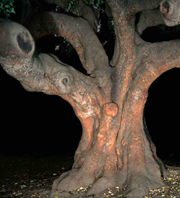Lynchings in the Old West
Bill Radke
Angela Kim
JANUARY 19, 2008
- Eternity 2007
- (Ken Gonzalez-Day)
- View the Slideshow
- Photographer Ken Gonzales-Day talks about lighting
- (Neille Ilel)
Bill Radke: We all know about so-called "frontier justice" in the Old West. But how are you defining lynching?
Web Resources
More From Bill Radke
More From Angela Kim
Ken Gonzales-Day: I use the Tuskegee Institute definition, which is sort of a guiding post to how we think about an execution that is illegal. For example, it says there has to be three or more people, there must be a presumption of guilt, and I also extended that by adding that there had to be a rope involved.
Victims of these western lynchings were primarily Latinos?
The largest single group, yes, were Latinos. And the largest section of that is what we would think as Mexican or Mexican-Americans today. After that, Native Americans, Chinese and Anglos of various different nations, including one Swiss.
You have photographed some of the trees that still exist today. You call them "hang trees." You brought some of your photos of these hang trees with you. I'm looking at this one, which is a California oak and it's next to some modern building.
It's some sort of business complex that hadn't yet been occupied at that point.
Tell us about this.
Lynch mobs in California preferred the California native oak over all other trees, partially because they're native, so they were here, and partially because they grow very slowly and have twisting branches that are low enough to throw a rope over. Part of my thinking was that these were the last witnesses. If it wasn't the exact tree, the mob walked underneath it on their way to the next tree. And my thought being that the tree has been there, and in some cases, they could be up to 400 years old. Capturing these last witnesses was part of the interest for me, because they may one day all be gone.
As you can see from the one that's been built around, the odds of that tree surviving are pretty slim, because you can see in the photograph that there's this lovely landscaping with little flowers and sprinklers. If you water that tree every day, it's probably going to be dead within five years.
How does this historical project, for you, relate to the America of today?
On one level, we can see it in the immigration debates that are going on all over the place. On another level, we can see it in debates around racial identity that are coming up in the elections, in the way that we think about who we are and who we are as a nation, not just as individuals.
I don't worry that lynching is going to come back, per se, though we have seen all the nooses and all kinds of manifestations of that coming back. But the ability to heal as a society has not yet happened. People get very sensitive, people get very insecure around these issues. And we just need to bring it out and talk about it.
You've related these lynchings to today's immigration debate, which is a little touchy. What connections do you make there?
Without being too provocative -- obviously we don't want to use the term "lynching" too loosely -- but lynching as a practice was only one aspect of the way Latinos were disenfranchised in the 19th century. They had restricted citizenship on a number of levels, and that could range from the business world to the economic world to the political world.
So when we talk about lynching, it is the most spectacular one; it's the one that we're drawn to as a people. But it's only one aspect of many aspects. The legacy of lynching is a very powerful one, and it can be a very frightening one and an intimidating one for all kinds of communities. So we need to come to a broader view of our understanding of race relations in the United States.
How do you feel differently knowing what you know now?
I think it helped me process a lot of different experiences that I had never really thought about. I guess I'll never look at trees quite the same way again. But when you think about the landscape in California, you probably think of the very pastoral, beautiful image. And it's probably taken by a number of Weston or Adams, or a number of photographers that are well known in their fields. They construct this idea of a landscape that is race neutral, in which there are no people, there are no races and there is no conflict. And part of my photographic journey has been to go back and look for these sites. They're still beautiful photographs. They're still beautiful trees, but I hope that the viewer will rethink their assumptions about how they look at photographs of landscapes.
Ken, thank you for talking with us today.
Thank you so much.
-
- Music Bridge:
- It Happened
- Artist: Cinder
- CD: Dirty Three (Drag City)







Comments
Comment | Refresh
Post a Comment: Please be civil, brief and relevant.
Email addresses are never displayed, but they are required to confirm your comments. All comments are moderated. Weekend America reserves the right to edit any comments on this site and to read them on the air if they are extra-interesting. Please read the Comment Guidelines before posting.
You must be 13 or over to submit information to American Public Media. The information entered into this form will not be used to send unsolicited email and will not be sold to a third party. For more information see Terms and Conditions and Privacy Policy.